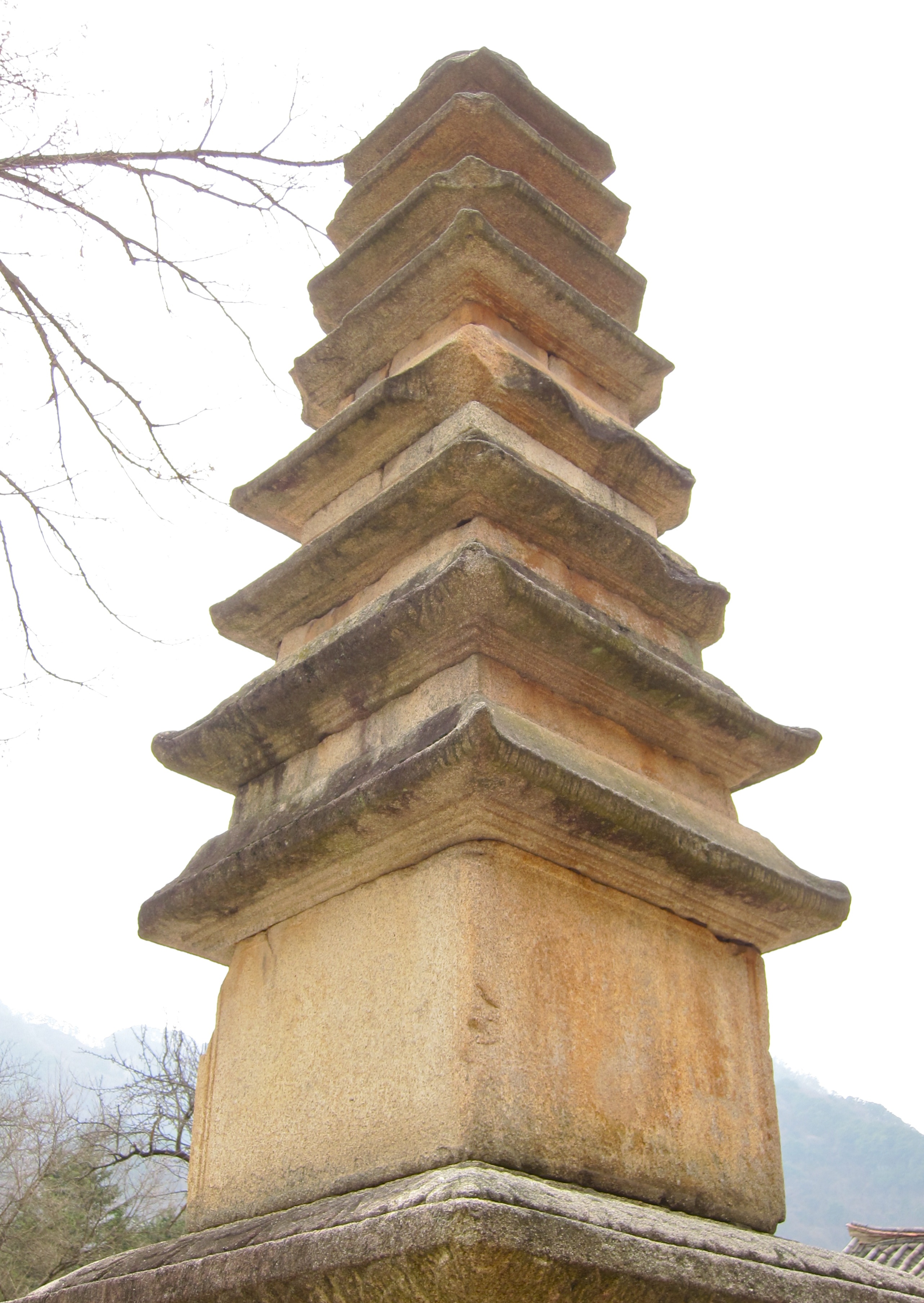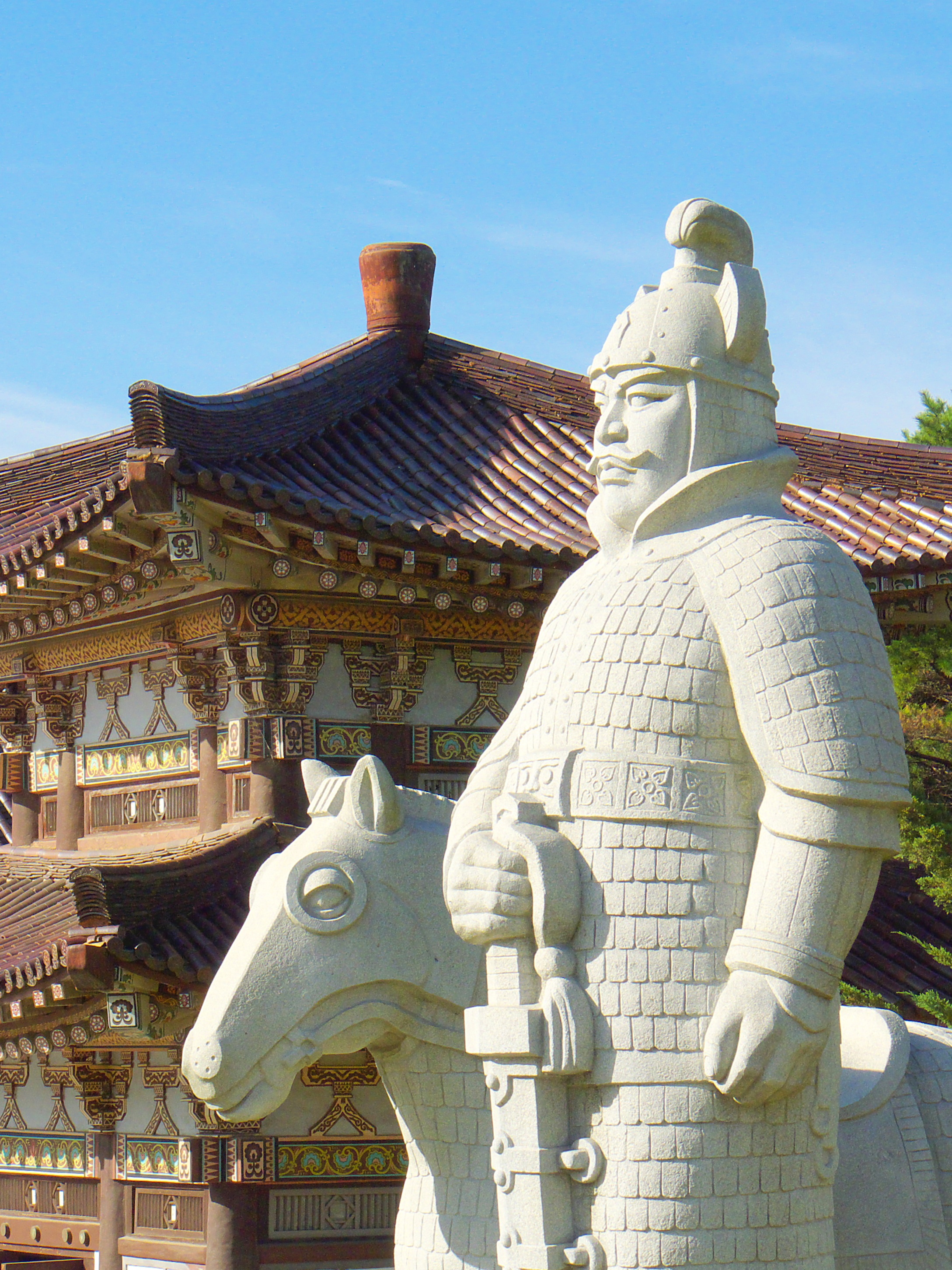|
Chilsongmun
Ch'ilsŏng Gate () is the northern gate of the inner castle of the walled city of Pyongyang (Pyongyang Castle). Located in the scenic Moranbong Park, the gate was originally built in the sixth century as an official Koguryo construction, although present construction dates from 1712. The gate takes its name (which literally means "seven stars") from the seven brightest stars in the Great Bear constellation (also known as the Big Dipper). This constellation was revered in traditional Korean religion - for example, many Buddhist temples in Korea contain a "Chilsong shrine" or other similar structure. Ch'ilsŏng Gate is National Treasure #16 in North Korea. Physical description The gate's walls are built into the Hill's embankment, piled with trimmed stones built into an arch gate. The walls are about 10 metres apart, with the gatehouse placed on top of them. There is a battlement and a gatehouse on the embankment. The gatehouse has three bays with single gable eaves, measuring 7 ... [...More Info...] [...Related Items...] OR: [Wikipedia] [Google] [Baidu] |
National Treasures Of North Korea
A National Treasure (국보; 國寶 : ) is a tangible artifact, site, or building deemed by the Government of North Korea to have significant historical or artistic value to the country. History The first list of Korean cultural treasures was designated by Governor-General of Korea in 1938 during the Japanese occupation with "The Act of Treasures of the Joseon dynasty". Nos. 1-50 Nos. 51-100 Nos. 101-150 Nos. 151-193 See also * Cultural assets of North Korea * Natural monuments of North Korea * National Treasure (South Korea) * Complex of Koguryo Tombs * History of Korea The Lower Paleolithic era in the Korean Peninsula and Manchuria began roughly half a million years ago. Christopher J. Norton, "The Current State of Korean Paleoanthropology", (2000), ''Journal of Human Evolution'', 38: 803–825. The earlies ... * Culture of Korea * List of World Heritage Sites in Asia#North Korea (1) Footnotes {{reflist References * http://www.kcpia.or.kr/kcpia_mail/mail ... [...More Info...] [...Related Items...] OR: [Wikipedia] [Google] [Baidu] |
Pyongyang
Pyongyang (, , ) is the capital and largest city of North Korea, where it is known as the "Capital of the Revolution". Pyongyang is located on the Taedong River about upstream from its mouth on the Yellow Sea. According to the 2008 population census, it has a population of 3,255,288. Pyongyang is a directly administered city () with equal status to North Korean provinces. Pyongyang is one of the oldest cities in Korea. It was the capital of two ancient Korean kingdoms, Gojoseon and Goguryeo, and served as the secondary capital of Goryeo. Much of the city was destroyed during the First Sino-Japanese War, but it was revived under Japanese rule and became an industrial center. Following the establishment of North Korea in 1948, Pyongyang became its ''de facto'' capital. The city was again devastated during the Korean War, but was quickly rebuilt after the war with Soviet assistance. Pyongyang is the political, industrial and transport center of North Korea. It is home to ... [...More Info...] [...Related Items...] OR: [Wikipedia] [Google] [Baidu] |
Pyongyang Castle
Pyongyang Castle is one of the National Treasures of North Korea. The castle was attacked by Geunchogo of Baekje in 375. In 427, Jangsu of Goguryeo transferred the Goguryeo capital from Gungnae Fortress (present-day Ji'an on the China-North Korea border) to Pyongyang Castle, a more suitable region to grow into a burgeoning metropolitan capital, which led Goguryeo to achieve a high level of cultural and economic prosperity. In 668, Pyongyang became the capital of the Protectorate General to Pacify the East established by the Tang dynasty of China. However, by 676, it was taken by Silla, but left on the border between Silla and Balhae. Pyongyang was left abandoned during the Later Silla period, until it was recovered by Wang Geon and decreed as the Western Capital of Goryeo. During the Joseon period, it became the provincial capital of Pyeongan Province. During the Japanese invasions of Korea (1592–98), Pyongyang was captured by the Japanese and held until they ... [...More Info...] [...Related Items...] OR: [Wikipedia] [Google] [Baidu] |
Moranbong Park
Moranbong or Moran Hill (literally "PeonyHill", often "PeonyPeak") forms a park located in central Pyongyang, the capital of North Korea. Its summit is the location of the Pyongyang TV Tower. There are multiple monumental structures located on Moran Hill. They include the Arch of Triumph, Kim Il-sung Stadium, and Kaeson Revolutionary Site. At the foot of the hill is the Jonsung Revolutionary Site, which conveys the "revolutionary achievements" of President Kim Il-sung and the Hungbu Revolutionary Site which is associated with the history of leader Kim Jong-il and includes trees bearing slogans written during the independence revolutionary struggle. The area surrounding the hill is now a recreation area, including the Moranbong Theatre, the Kaeson Youth Park, an open-air theatre in the Youth Park, the Moran Restaurant, an afforestation exhibition and a small zoo. The Okryu Restaurant is also located nearby. See also * Pyongyang Castle * Moranbong Band * Moran ... [...More Info...] [...Related Items...] OR: [Wikipedia] [Google] [Baidu] |
Koguryo
Goguryeo (37 BC–668 AD) ( ) also called Goryeo (), was a Korean kingdom located in the northern and central parts of the Korean Peninsula and the southern and central parts of Northeast China. At its peak of power, Goguryeo controlled most of the Korean peninsula, large parts of Manchuria and parts of eastern Mongolia and Inner Mongolia. Along with Baekje and Silla, Goguryeo was one of the Three Kingdoms of Korea. It was an active participant in the power struggle for control of the Korean peninsula and was also associated with the foreign affairs of neighboring polities in China and Yamato period, Japan. The ''Samguk sagi'', a 12th-century text from Goryeo, indicates that Goguryeo was founded in 37 BC by Jumong (), a prince from Buyeo, who was enthroned as Dongmyeong of Goguryeo, Dongmyeong. Goguryeo was one of the great powers in East Asia, until its defeat by a Silla–Tang alliance in 668 after prolonged exhaustion and internal strife caused by the death of Yeon Gaeso ... [...More Info...] [...Related Items...] OR: [Wikipedia] [Google] [Baidu] |
Ursa Major
Ursa Major (; also known as the Great Bear) is a constellation in the northern sky, whose associated mythology likely dates back into prehistory. Its Latin name means "greater (or larger) bear," referring to and contrasting it with nearby Ursa Minor, the lesser bear. In antiquity, it was one of the original 48 constellations listed by Ptolemy in the 2nd century AD, drawing on earlier works by Greek, Egyptian, Babylonian, and Assyrian astronomers. Today it is the third largest of the 88 modern constellations. Ursa Major is primarily known from the asterism of its main seven stars, which has been called the " Big Dipper," "the Wagon," "Charles's Wain," or "the Plough," among other names. In particular, the Big Dipper's stellar configuration mimics the shape of the " Little Dipper." Two of its stars, named Dubhe and Merak ( α Ursae Majoris and β Ursae Majoris), can be used as the navigational pointer towards the place of the current northern pole star, Polaris in Ursa Mino ... [...More Info...] [...Related Items...] OR: [Wikipedia] [Google] [Baidu] |
Big Dipper
The Big Dipper ( US, Canada) or the Plough ( UK, Ireland) is a large asterism consisting of seven bright stars of the constellation Ursa Major; six of them are of second magnitude and one, Megrez (δ), of third magnitude. Four define a "bowl" or "body" and three define a "handle" or "head". It is recognized as a distinct grouping in many cultures. The North Star (Polaris), the current northern pole star and the tip of the handle of the Little Dipper (Little Bear), can be located by extending an imaginary line through the front two stars of the asterism, Merak (β) and Dubhe (α). This makes it useful in celestial navigation. Names and places The constellation of ''Ursa Major'' (Latin: Greater Bear) has been seen as a bear, a wagon, or a ladle. The "bear" tradition is Indo-European (appearing in Greek, as well as in Vedic India), but apparently the name "bear" has parallels in Siberian or North American traditions. European astronomy The name "Bear" is Homeric, and ... [...More Info...] [...Related Items...] OR: [Wikipedia] [Google] [Baidu] |
Buddhism In Korea
Korean Buddhism is distinguished from other forms of Buddhism by its attempt to resolve what its early practitioners saw as inconsistencies within the Mahayana Buddhist traditions that they received from foreign countries. To address this, they developed a new holistic approach to Buddhism that became a distinct form, an approach characteristic of virtually all major Korean thinkers. The resulting variation is called '' Tongbulgyo'' ("interpenetrated Buddhism"), a form that sought to harmonize previously arising disputes among scholars (a principle called ''hwajaeng'' 和諍). Centuries after Buddhism originated in India, the Mahayana tradition arrived in China through the Silk Road in the 1st century CE via Tibet; it then entered the Korean peninsula in the 3rd century during the Three Kingdoms Period, from where it was transmitted to Japan. In Korea, it was adopted as the state religion of 3 constituent polities of the Three Kingdoms Period, first by the Goguryeo (also kn ... [...More Info...] [...Related Items...] OR: [Wikipedia] [Google] [Baidu] |
Korean Buddhist Temples
Buddhist temples are an important part of the Korean landscape. This article gives a brief overview of Korean Buddhism, then describes some of the more important temples in Korea. Most Korean temples have names ending in ''-sa'' (사, 寺), which means "temple" in Sino-Korean. Many temples, like Sudeoksa, offer visitors a Temple Stay program. Background A distinctive form of Buddhism evolved in Korea. This was facilitated by the geographical location and cultural conditions. Buddhism first arrived in Korea in 372 in Goguryeo. In 374 the influential Han Chinese monk Ado arrived in the kingdom and inspired King Sosurim of Goguryeo the following year. The first two temples Seongmunsa and Ilbullansa were built in 375 on the order of the king. Buddhism soon became the national religion of Goguryeo. With the advent of Taoism in 624 the rulers began to suppress Buddhism and its importance quickly declined. The Baekje Kingdom, on the other hand, flourished under the influence of B ... [...More Info...] [...Related Items...] OR: [Wikipedia] [Google] [Baidu] |
Buildings And Structures In Pyongyang
A building, or edifice, is an enclosed structure with a roof and walls standing more or less permanently in one place, such as a house or factory (although there's also portable buildings). Buildings come in a variety of sizes, shapes, and functions, and have been adapted throughout history for a wide number of factors, from building materials available, to weather conditions, land prices, ground conditions, specific uses, prestige, and aesthetic reasons. To better understand the term ''building'' compare the list of nonbuilding structures. Buildings serve several societal needs – primarily as shelter from weather, security, living space, privacy, to store belongings, and to comfortably live and work. A building as a shelter represents a physical division of the human habitat (a place of comfort and safety) and the ''outside'' (a place that at times may be harsh and harmful). Ever since the first cave paintings, buildings have also become objects or canvasses of much artis ... [...More Info...] [...Related Items...] OR: [Wikipedia] [Google] [Baidu] |






